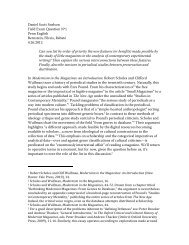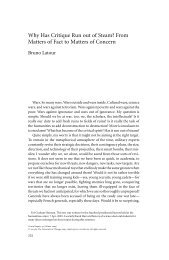The Exploit: A Theory of Networks - asounder
The Exploit: A Theory of Networks - asounder
The Exploit: A Theory of Networks - asounder
You also want an ePaper? Increase the reach of your titles
YUMPU automatically turns print PDFs into web optimized ePapers that Google loves.
68 Nodes<br />
example), the interesting thing about swarming is the nagging tension<br />
in being “amorphous but coordinated.” How is it possible to control<br />
something that is by definition constituted by its own dispersal,<br />
by being radically distributed, spread out, and horizontal?<br />
Answering this question in the context <strong>of</strong> conflict (military or civilian)<br />
means addressing the question <strong>of</strong> enmity. That is, if “control” in conflict is<br />
ordinarily situated around a relationship <strong>of</strong> enmity (friend - foe, ally - enemy),<br />
and if this relation <strong>of</strong> enmity structures the organization <strong>of</strong> conflict (symmetrical<br />
stand<strong>of</strong>f, insurgency, civil disobedience), what happens when enmity<br />
dissolves in the intangible swarm?<br />
In part this is the question <strong>of</strong> how conflict is structured in terms <strong>of</strong><br />
more complex modes <strong>of</strong> enmity (“going underground,” “low - intensity<br />
conflict,” the “war on terror”). Are the terms <strong>of</strong> enmity accurate for<br />
such conflicts? Perhaps it is not possible for a network to be an enemy?<br />
Without ignoring their political differences, is there a topological<br />
shift common to them all that involves a dissolving or a “defacing” <strong>of</strong><br />
enmity? Can a swarm be handled? If there is no foe to face, how does<br />
one face a foe? It is not so much that the foe has a face, but that the<br />
foe is faced, that “facing” is a process, a verb, an action in the making.<br />
This is Levinas’s approach to the ethical encounter, an encounter<br />
that is based not on enmity but on a “calling into question” <strong>of</strong> the<br />
self. But in a different vein, it is also the approach <strong>of</strong> Deleuze and<br />
Guattari when they speak <strong>of</strong> “faciality.” Not unlike Levinas, they stress<br />
the phenomenal, affective quality <strong>of</strong> “facing.” But they also take “facing”<br />
(facing the other, facing a foe) to be a matter <strong>of</strong> pattern recognition,<br />
a certain ordering <strong>of</strong> holes, lines, curves: “<strong>The</strong> head is included<br />
in the body, but the face is not. <strong>The</strong> face is a surface: facial traits,<br />
lines, wrinkles; long face, square face, triangular face; the face is a<br />
map, even when it is applied to and wraps a volume, even when it<br />
surrounds and borders cavities that are now no more than holes.” 38<br />
Faciality is, in a more mundane sense, one’s recognition <strong>of</strong> other human<br />
faces, and thus one’s habit <strong>of</strong> facing, encountering, meeting others<br />
all the time. But for Deleuze and Guattari, the fundamental process<br />
<strong>of</strong> faciality also leads to a deterritorialization <strong>of</strong> the familiar face, and<br />
to the proliferation <strong>of</strong> faces, in the snow, on the wall, in the clouds,<br />
and in other places (where faces shouldn’t be) . . .









